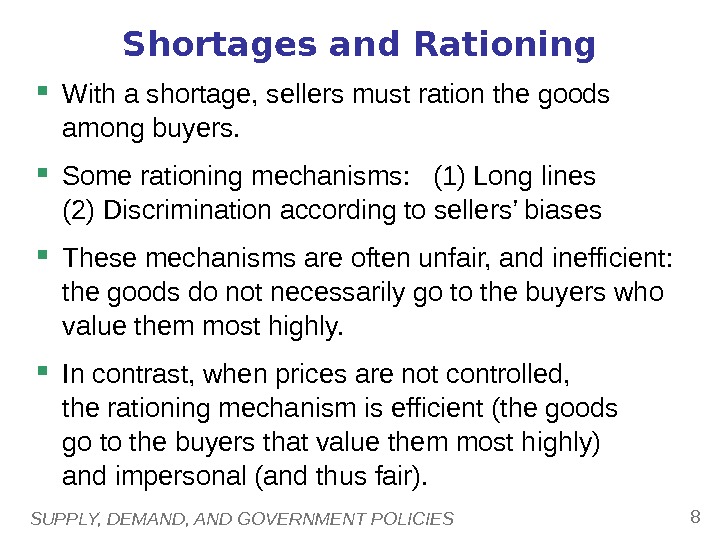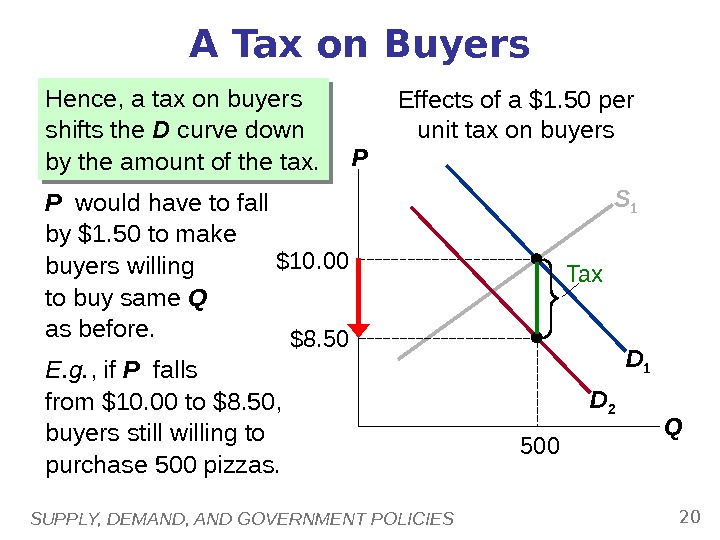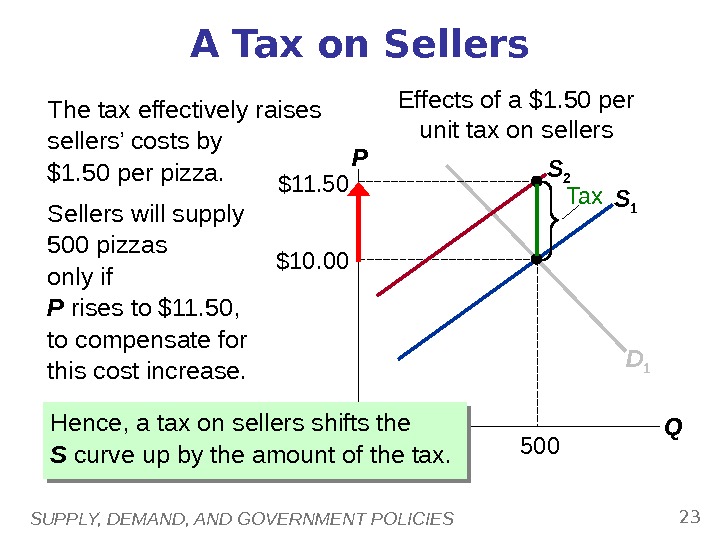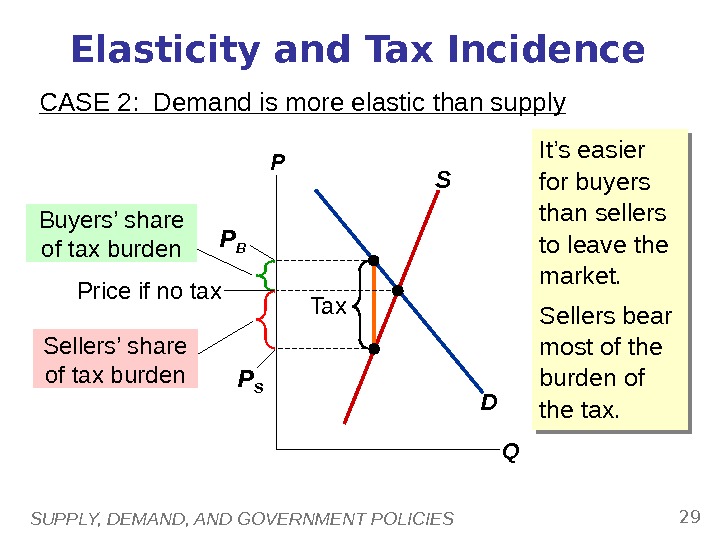Презентация princ-ch06-presentation



































- Размер: 949 Кб
- Количество слайдов: 34
Описание презентации Презентация princ-ch06-presentation по слайдам
 © 2009 South-Western, a part of Cengage Learning, all rights reserved. C H A P T E R Supply, Demand, and Government Policies E conomics P R I N C I P L E S O F N. Gregory Mankiw Premium Power. Point Slides by Ron Cronovich
© 2009 South-Western, a part of Cengage Learning, all rights reserved. C H A P T E R Supply, Demand, and Government Policies E conomics P R I N C I P L E S O F N. Gregory Mankiw Premium Power. Point Slides by Ron Cronovich
 In this chapter, look for the answers to these questions: What are price ceilings and price floors? What are some examples of each? How do price ceilings and price floors affect market outcomes? How do taxes affect market outcomes? How do the effects depend on whether the tax is imposed on buyers or sellers? What is the incidence of a tax? What determines the incidence?
In this chapter, look for the answers to these questions: What are price ceilings and price floors? What are some examples of each? How do price ceilings and price floors affect market outcomes? How do taxes affect market outcomes? How do the effects depend on whether the tax is imposed on buyers or sellers? What is the incidence of a tax? What determines the incidence?
 SUPPLY, DEMAND, AND GOVERNMENT POLICIES 3 Government Policies That Alter the Private Market Outcome Price controls Price ceiling : a legal maximum on the price of a good or service Example: rent control Price floor : a legal minimum on the price of a good or service Example: minimum wage Taxes The govt can make buyers or sellers pay a specific amount on each unit bought/sold. We will use the supply/demand model to see how each policy affects the market outcome (the price buyers pay, the price sellers receive, and eq’m quantity).
SUPPLY, DEMAND, AND GOVERNMENT POLICIES 3 Government Policies That Alter the Private Market Outcome Price controls Price ceiling : a legal maximum on the price of a good or service Example: rent control Price floor : a legal minimum on the price of a good or service Example: minimum wage Taxes The govt can make buyers or sellers pay a specific amount on each unit bought/sold. We will use the supply/demand model to see how each policy affects the market outcome (the price buyers pay, the price sellers receive, and eq’m quantity).
 SUPPLY, DEMAND, AND GOVERNMENT POLICIES 4 EXAMPLE 1: The Market for Apartments Eq’m w/o price controls P QDS Rental price of apts $800 300 Quantity of apartments
SUPPLY, DEMAND, AND GOVERNMENT POLICIES 4 EXAMPLE 1: The Market for Apartments Eq’m w/o price controls P QDS Rental price of apts $800 300 Quantity of apartments
 SUPPLY, DEMAND, AND GOVERNMENT POLICIES 5 How Price Ceilings Affect Market Outcomes A price ceiling above the eq’m price is not binding – has no effect on the market outcome. P QDS $800 300 Price ceiling$
SUPPLY, DEMAND, AND GOVERNMENT POLICIES 5 How Price Ceilings Affect Market Outcomes A price ceiling above the eq’m price is not binding – has no effect on the market outcome. P QDS $800 300 Price ceiling$
 SUPPLY, DEMAND, AND GOVERNMENT POLICIES 6 How Price Ceilings Affect Market Outcomes The eq’m price ($800) is above the ceiling and therefore illegal. The ceiling is a binding constraint on the price, causes a shortage. P QDS $800 Price ceiling$500 250 400 shortage
SUPPLY, DEMAND, AND GOVERNMENT POLICIES 6 How Price Ceilings Affect Market Outcomes The eq’m price ($800) is above the ceiling and therefore illegal. The ceiling is a binding constraint on the price, causes a shortage. P QDS $800 Price ceiling$500 250 400 shortage
 SUPPLY, DEMAND, AND GOVERNMENT POLICIES 7 How Price Ceilings Affect Market Outcomes In the long run, supply and demand are more price-elastic. So, the shortage is larger. P QDS $800 150 Price ceiling$500 450 shortage
SUPPLY, DEMAND, AND GOVERNMENT POLICIES 7 How Price Ceilings Affect Market Outcomes In the long run, supply and demand are more price-elastic. So, the shortage is larger. P QDS $800 150 Price ceiling$500 450 shortage
 SUPPLY, DEMAND, AND GOVERNMENT POLICIES 8 Shortages and Rationing With a shortage, sellers must ration the goods among buyers. Some rationing mechanisms: (1) Long lines (2) Discrimination according to sellers’ biases These mechanisms are often unfair, and inefficient: the goods do not necessarily go to the buyers who value them most highly. In contrast, when prices are not controlled, the rationing mechanism is efficient (the goods go to the buyers that value them most highly) and impersonal (and thus fair).
SUPPLY, DEMAND, AND GOVERNMENT POLICIES 8 Shortages and Rationing With a shortage, sellers must ration the goods among buyers. Some rationing mechanisms: (1) Long lines (2) Discrimination according to sellers’ biases These mechanisms are often unfair, and inefficient: the goods do not necessarily go to the buyers who value them most highly. In contrast, when prices are not controlled, the rationing mechanism is efficient (the goods go to the buyers that value them most highly) and impersonal (and thus fair).
 SUPPLY, DEMAND, AND GOVERNMENT POLICIES 9 EXAMPLE 2: The Market for Unskilled Labor Eq’m w/o price controls W LDS Wage paid to unskilled workers $4 500 Quantity of unskilled workers
SUPPLY, DEMAND, AND GOVERNMENT POLICIES 9 EXAMPLE 2: The Market for Unskilled Labor Eq’m w/o price controls W LDS Wage paid to unskilled workers $4 500 Quantity of unskilled workers
 SUPPLY, DEMAND, AND GOVERNMENT POLICIES 10 How Price Floors Affect Market Outcomes W LDS $4 500 Price floor$3 A price floor below the eq’m price is not binding – has no effect on the market outcome.
SUPPLY, DEMAND, AND GOVERNMENT POLICIES 10 How Price Floors Affect Market Outcomes W LDS $4 500 Price floor$3 A price floor below the eq’m price is not binding – has no effect on the market outcome.
 SUPPLY, DEMAND, AND GOVERNMENT POLICIES 11 How Price Floors Affect Market Outcomes W LDS $4 Price floor$5 The eq’m wage ($4) is below the floor and therefore illegal. The floor is a binding constraint on the wage, causes a surplus ( i. e. , unemployment). 400 550 labor surplus
SUPPLY, DEMAND, AND GOVERNMENT POLICIES 11 How Price Floors Affect Market Outcomes W LDS $4 Price floor$5 The eq’m wage ($4) is below the floor and therefore illegal. The floor is a binding constraint on the wage, causes a surplus ( i. e. , unemployment). 400 550 labor surplus
 SUPPLY, DEMAND, AND GOVERNMENT POLICIES 12 Min wage laws do not affect highly skilled workers. They do affect teen workers. Studies: A 10% increase in the min wage raises teen unemployment by 1 -3%. The Minimum Wage W LDS $4 Min. wage$5 400 550 unemp-l oyment
SUPPLY, DEMAND, AND GOVERNMENT POLICIES 12 Min wage laws do not affect highly skilled workers. They do affect teen workers. Studies: A 10% increase in the min wage raises teen unemployment by 1 -3%. The Minimum Wage W LDS $4 Min. wage$5 400 550 unemp-l oyment
 A C T I V E L E A R N I N G 11 Price controls QP S 0 The market for hotel rooms DDetermine effects of: A. $90 price ceiling B. $90 price floor C. $120 price floor
A C T I V E L E A R N I N G 11 Price controls QP S 0 The market for hotel rooms DDetermine effects of: A. $90 price ceiling B. $90 price floor C. $120 price floor
 A C T I V E L E A R N I N G 11 A. $90 price ceiling QP S 0 The market for hotel rooms DThe price falls to $90. Buyers demand 120 rooms, sellers supply 90, leaving a shortage = 30 Price ceiling
A C T I V E L E A R N I N G 11 A. $90 price ceiling QP S 0 The market for hotel rooms DThe price falls to $90. Buyers demand 120 rooms, sellers supply 90, leaving a shortage = 30 Price ceiling
 A C T I V E L E A R N I N G 11 B. $90 price floor QP S 0 The market for hotel rooms DEq’m price is above the floor, so floor is not binding. P = $100, Q = 100 rooms. Price floor
A C T I V E L E A R N I N G 11 B. $90 price floor QP S 0 The market for hotel rooms DEq’m price is above the floor, so floor is not binding. P = $100, Q = 100 rooms. Price floor
 A C T I V E L E A R N I N G 11 C. $120 price floor QP S 0 The market for hotel rooms DThe price rises to $120. Buyers demand 60 rooms, sellers supply 120, causing a surplus = 60 Price floor
A C T I V E L E A R N I N G 11 C. $120 price floor QP S 0 The market for hotel rooms DThe price rises to $120. Buyers demand 60 rooms, sellers supply 120, causing a surplus = 60 Price floor
 SUPPLY, DEMAND, AND GOVERNMENT POLICIES 17 Evaluating Price Controls Recall one of the Ten Principles from Chapter 1: Markets are usually a good way to organize economic activity. Prices are the signals that guide the allocation of society’s resources. This allocation is altered when policymakers restrict prices. Price controls often intended to help the poor, but often hurt more than help.
SUPPLY, DEMAND, AND GOVERNMENT POLICIES 17 Evaluating Price Controls Recall one of the Ten Principles from Chapter 1: Markets are usually a good way to organize economic activity. Prices are the signals that guide the allocation of society’s resources. This allocation is altered when policymakers restrict prices. Price controls often intended to help the poor, but often hurt more than help.
 SUPPLY, DEMAND, AND GOVERNMENT POLICIES 18 Taxes The govt levies taxes on many goods & services to raise revenue to pay for national defense, public schools, etc. The govt can make buyers or sellers pay the tax. The tax can be a % of the good’s price, or a specific amount for each unit sold. For simplicity, we analyze per-unit taxes only.
SUPPLY, DEMAND, AND GOVERNMENT POLICIES 18 Taxes The govt levies taxes on many goods & services to raise revenue to pay for national defense, public schools, etc. The govt can make buyers or sellers pay the tax. The tax can be a % of the good’s price, or a specific amount for each unit sold. For simplicity, we analyze per-unit taxes only.
 SUPPLY, DEMAND, AND GOVERNMENT POLICIES 19 S 1 EXAMPLE 3: The Market for Pizza Eq’m w/o tax P QD 1$10.
SUPPLY, DEMAND, AND GOVERNMENT POLICIES 19 S 1 EXAMPLE 3: The Market for Pizza Eq’m w/o tax P QD 1$10.
 SUPPLY, DEMAND, AND GOVERNMENT POLICIES 20 S 1 D 1$10. 00 500 A Tax on Buyers The price buyers pay is now $1. 50 higher than the market price P. P would have to fall by $1. 50 to make buyers willing to buy same Q as before. E. g. , if P falls from $10. 00 to $8. 50, buyers still willing to purchase 500 pizzas. P QD 2 Effects of a $1. 50 per unit tax on buyers $8. 50 Hence, a tax on buyers shifts the D curve down by the amount of the tax. Tax
SUPPLY, DEMAND, AND GOVERNMENT POLICIES 20 S 1 D 1$10. 00 500 A Tax on Buyers The price buyers pay is now $1. 50 higher than the market price P. P would have to fall by $1. 50 to make buyers willing to buy same Q as before. E. g. , if P falls from $10. 00 to $8. 50, buyers still willing to purchase 500 pizzas. P QD 2 Effects of a $1. 50 per unit tax on buyers $8. 50 Hence, a tax on buyers shifts the D curve down by the amount of the tax. Tax
 SUPPLY, DEMAND, AND GOVERNMENT POLICIES 21 S 1 D 1$10. 00 500 A Tax on Buyers P QD 2$11. 00 P B = $9. 50 P S = Tax. Effects of a $1. 50 per unit tax on buyers. New eq’m: Q = 450 Sellers receive P S = $9. 50 Buyers pay P B = $11. 00 Difference between them = $1. 50 = tax
SUPPLY, DEMAND, AND GOVERNMENT POLICIES 21 S 1 D 1$10. 00 500 A Tax on Buyers P QD 2$11. 00 P B = $9. 50 P S = Tax. Effects of a $1. 50 per unit tax on buyers. New eq’m: Q = 450 Sellers receive P S = $9. 50 Buyers pay P B = $11. 00 Difference between them = $1. 50 = tax
 SUPPLY, DEMAND, AND GOVERNMENT POLICIES 22450 S 1 The Incidence of a Tax: how the burden of a tax is shared among market participants P QD 1$10. 00 500 D 2$11. 00 P B = $9. 50 P S = Tax. In our example, buyers pay $1. 00 more, sellers get $0. 50 less.
SUPPLY, DEMAND, AND GOVERNMENT POLICIES 22450 S 1 The Incidence of a Tax: how the burden of a tax is shared among market participants P QD 1$10. 00 500 D 2$11. 00 P B = $9. 50 P S = Tax. In our example, buyers pay $1. 00 more, sellers get $0. 50 less.
 SUPPLY, DEMAND, AND GOVERNMENT POLICIES 23 S 1 A Tax on Sellers P QD 1$10. 00 500 S 2 Effects of a $1. 50 per unit tax on sellers. The tax effectively raises sellers’ costs by $1. 50 per pizza. Sellers will supply 500 pizzas only if P rises to $11. 50, to compensate for this cost increase. $11. 50 Hence, a tax on sellers shifts the S curve up by the amount of the tax. Tax
SUPPLY, DEMAND, AND GOVERNMENT POLICIES 23 S 1 A Tax on Sellers P QD 1$10. 00 500 S 2 Effects of a $1. 50 per unit tax on sellers. The tax effectively raises sellers’ costs by $1. 50 per pizza. Sellers will supply 500 pizzas only if P rises to $11. 50, to compensate for this cost increase. $11. 50 Hence, a tax on sellers shifts the S curve up by the amount of the tax. Tax
 SUPPLY, DEMAND, AND GOVERNMENT POLICIES 24 S 1 A Tax on Sellers P QD 1$10. 00 500 S 2 450$11. 00 P B = $9. 50 P S = Tax. Effects of a $1. 50 per unit tax on sellers. New eq’m: Q = 450 Buyers pay P B = $11. 00 Sellers receive P S = $9. 50 Difference between them = $1. 50 = tax
SUPPLY, DEMAND, AND GOVERNMENT POLICIES 24 S 1 A Tax on Sellers P QD 1$10. 00 500 S 2 450$11. 00 P B = $9. 50 P S = Tax. Effects of a $1. 50 per unit tax on sellers. New eq’m: Q = 450 Buyers pay P B = $11. 00 Sellers receive P S = $9. 50 Difference between them = $1. 50 = tax
 SUPPLY, DEMAND, AND GOVERNMENT POLICIES 25 S 1 The Outcome Is the Same in Both Cases ! What matters is this: A tax drives a wedge between the price buyers pay and the price sellers receive. P QD 1$10. 00 500450$9. 50$11. 00 P B = P S = Tax. The effects on P and Q , and the tax incidence are the same whether the tax is imposed on buyers or sellers!
SUPPLY, DEMAND, AND GOVERNMENT POLICIES 25 S 1 The Outcome Is the Same in Both Cases ! What matters is this: A tax drives a wedge between the price buyers pay and the price sellers receive. P QD 1$10. 00 500450$9. 50$11. 00 P B = P S = Tax. The effects on P and Q , and the tax incidence are the same whether the tax is imposed on buyers or sellers!
 A C T I V E L E A R N I N G 22 Effects of a tax QP S 0 The market for hotel rooms DSuppose govt imposes a tax on buyers of $30 per room. Find new Q , P B , P S , and incidence of tax.
A C T I V E L E A R N I N G 22 Effects of a tax QP S 0 The market for hotel rooms DSuppose govt imposes a tax on buyers of $30 per room. Find new Q , P B , P S , and incidence of tax.
 A C T I V E L E A R N I N G 22 Answers QP S 0 The market for hotel rooms DQ = 80 P B = $110 P S = $80 Incidence buyers: $10 sellers: $20 Tax. P B = P S =
A C T I V E L E A R N I N G 22 Answers QP S 0 The market for hotel rooms DQ = 80 P B = $110 P S = $80 Incidence buyers: $10 sellers: $20 Tax. P B = P S =
 SUPPLY, DEMAND, AND GOVERNMENT POLICIES 28 Elasticity and Tax Incidence CASE 1: Supply is more elastic than demand P QD S Tax. Buyers’ share of tax burden Sellers’ share of tax burden Price if no tax P B P S It’s easier for sellers than buyers to leave the market. So buyers bear most of the burden of the tax.
SUPPLY, DEMAND, AND GOVERNMENT POLICIES 28 Elasticity and Tax Incidence CASE 1: Supply is more elastic than demand P QD S Tax. Buyers’ share of tax burden Sellers’ share of tax burden Price if no tax P B P S It’s easier for sellers than buyers to leave the market. So buyers bear most of the burden of the tax.
 SUPPLY, DEMAND, AND GOVERNMENT POLICIES 29 Elasticity and Tax Incidence CASE 2: Demand is more elastic than supply P QDS Tax. Buyers’ share of tax burden Sellers’ share of tax burden Price if no tax P B P S It’s easier for buyers than sellers to leave the market. Sellers bear most of the burden of the tax.
SUPPLY, DEMAND, AND GOVERNMENT POLICIES 29 Elasticity and Tax Incidence CASE 2: Demand is more elastic than supply P QDS Tax. Buyers’ share of tax burden Sellers’ share of tax burden Price if no tax P B P S It’s easier for buyers than sellers to leave the market. Sellers bear most of the burden of the tax.
 SUPPLY, DEMAND, AND GOVERNMENT POLICIES 30 CASE STUDY: Who Pays the Luxury Tax? 1990: Congress adopted a luxury tax on yachts, private airplanes, furs, expensive cars, etc. Goal of the tax: raise revenue from those who could most easily afford to pay – wealthy consumers. But who really pays this tax?
SUPPLY, DEMAND, AND GOVERNMENT POLICIES 30 CASE STUDY: Who Pays the Luxury Tax? 1990: Congress adopted a luxury tax on yachts, private airplanes, furs, expensive cars, etc. Goal of the tax: raise revenue from those who could most easily afford to pay – wealthy consumers. But who really pays this tax?
 SUPPLY, DEMAND, AND GOVERNMENT POLICIES 31 CASE STUDY: Who Pays the Luxury Tax? The market for yachts P QDS Tax. Buyers’ share of tax burden Sellers’ share of tax burden P B P S Demand is price-elastic. In the short run, supply is inelastic. Hence, companies that build yachts pay most of the tax.
SUPPLY, DEMAND, AND GOVERNMENT POLICIES 31 CASE STUDY: Who Pays the Luxury Tax? The market for yachts P QDS Tax. Buyers’ share of tax burden Sellers’ share of tax burden P B P S Demand is price-elastic. In the short run, supply is inelastic. Hence, companies that build yachts pay most of the tax.
 SUPPLY, DEMAND, AND GOVERNMENT POLICIES 32 CONCLUSION: Government Policies and the Allocation of Resources Each of the policies in this chapter affects the allocation of society’s resources. Example 1: A tax on pizza reduces eq’m Q. With less production of pizza, resources (workers, ovens, cheese) will become available to other industries. Example 2: A binding minimum wage causes a surplus of workers, a waste of resources. So, it’s important for policymakers to apply such policies very carefully.
SUPPLY, DEMAND, AND GOVERNMENT POLICIES 32 CONCLUSION: Government Policies and the Allocation of Resources Each of the policies in this chapter affects the allocation of society’s resources. Example 1: A tax on pizza reduces eq’m Q. With less production of pizza, resources (workers, ovens, cheese) will become available to other industries. Example 2: A binding minimum wage causes a surplus of workers, a waste of resources. So, it’s important for policymakers to apply such policies very carefully.
 CHAPTER SUMMARY A price ceiling is a legal maximum on the price of a good. An example is rent control. If the price ceiling is below the eq’m price, it is binding and causes a shortage. A price floor is a legal minimum on the price of a good. An example is the minimum wage. If the price floor is above the eq’m price, it is binding and causes a surplus. The labor surplus caused by the minimum wage is unemployment.
CHAPTER SUMMARY A price ceiling is a legal maximum on the price of a good. An example is rent control. If the price ceiling is below the eq’m price, it is binding and causes a shortage. A price floor is a legal minimum on the price of a good. An example is the minimum wage. If the price floor is above the eq’m price, it is binding and causes a surplus. The labor surplus caused by the minimum wage is unemployment.
 CHAPTER SUMMARY A tax on a good places a wedge between the price buyers pay and the price sellers receive, and causes the eq’m quantity to fall, whether the tax is imposed on buyers or sellers. The incidence of a tax is the division of the burden of the tax between buyers and sellers, and does not depend on whether the tax is imposed on buyers or sellers. The incidence of the tax depends on the price elasticities of supply and demand.
CHAPTER SUMMARY A tax on a good places a wedge between the price buyers pay and the price sellers receive, and causes the eq’m quantity to fall, whether the tax is imposed on buyers or sellers. The incidence of a tax is the division of the burden of the tax between buyers and sellers, and does not depend on whether the tax is imposed on buyers or sellers. The incidence of the tax depends on the price elasticities of supply and demand.

